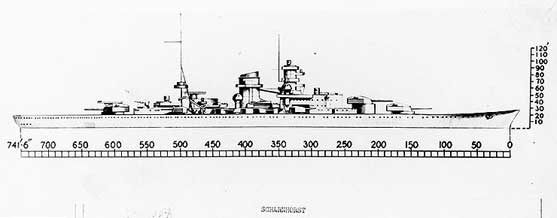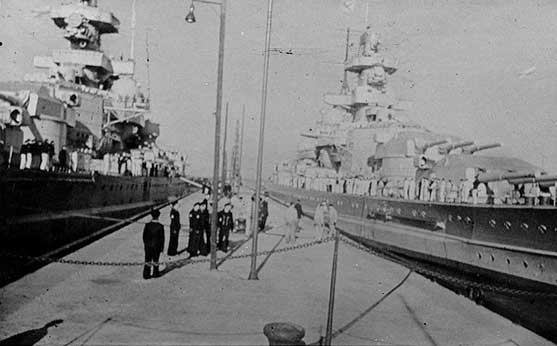| Salmon
and Gluckstein Revisited
Part Four
By Kristin Ann High
September 2019
 Click
here for Part Three. Click
here for Part Three.
The Channel Dash
Scharnhorst and Gneisenau spent a long year
in Brest, constantly attacked by the RAF
and indifferently protected by the Luftwaffe.
Daylight attacks badly damaged both ships. Gneisenau was both torpedoed and bombed in
Brest, and the dock where she was refitting
was also damaged by both torpedoes and bombs. Scharnhorst was bombed at La Pallice while
working up, and again at Brest while under
repair.
Indeed, it became much more dangerous to
work the ships up than it had been to sortie
on operations. Prinz Eugen joined
the ships on 1st June 1941, after the failure
of Operation Rheinübung. Like the two battlecruisers, Prinz Eugen was treated to bombing and torpedo
raids through the summer and winter, being
hit at least once. At some point in the late
summer or early fall of 1941, the OKW resolved
an interservice wrangle between the Kriegsmarine
and the Luftwaffe by passing the buck to
der Führer, who sided with Göring,
more or less; certainly any hope for moving
day fighter squadrons to Brest was quashed.
Despite the lack
of fighter cover, the big ships had powerful
secondary defences in Brest, including
naval FlaK units in addition to the Luftwaffe
FlaK (which had not been withdrawn), and
an excellent smoke screen which made bombing
rather a miss-and-hit affair—which did not improve Anglo-French
relations when bombs fell on French citizens.
Eventually, however, the Führer decided
the heavy ships must be withdrawn from France
and placed where they could aid the struggle
in the East—in Norway. After a bitter
series of meetings with Hitler, Raeder finally
gave up and agreed to a breakout from Brest
for Scharnhorst, Gneisenau, and Prinz
Eugen.
The route chosen was a direct sortie at high
speed through the English channel and into
Germany. Hitler liked the idea [35], and
Unternehmen Zerberus was born.

An Allied "recognition drawing" of Scharnhorst.
The British had several
means of discerning German intentions.
Although Naval Enigma remained the most
difficult to crack, Luftwaffe Enigma was
read on a daily basis—in
large part because of the appalling signals
security practiced by Luftwaffe units, including
both OKL and the ObdL. As the Luftwaffe was
committed in almost its full strength in
the West, the British knew that "something
big" was brewing, and probably that
some sort of sortie by the heavy ships was
planned. The Allies also had an agent in
Brest, a French naval officer code-named “Hilarion,” who
was able to keep them up to date on the state
of German ships maintenance and preparations
for sailing.
Between the Admiralty
and Coastal Command, a solid appreciation
of the German operation was drawn up, giving
the British the general route of the sortie,
and the dates most favourable for executing
it. The fatal mistake in the British plan
to counter the sortie—Operation “Fuller”—was
the appreciation of how the heavy ships would
force the English Channel. The German ships
could not make the full voyage under the
cover of a single night period, even in winter.
This being so, the Admiralty and Coastal
Command reasoned, quite sensibly, that the
Germans would make a staged sortie, sailing
at night and seeking refuge in French ports
during daylight. With the obvious Luftwaffe
activity, this plan had much to recommend
it; in French ports, the heavy ships would
be very difficult to get at with MTBs or
destroyers, while air attacks would face
serious fighter defences.
Unfortunately, this
assessment became the sole basis for planning “Fuller.” Something
about the malign winter of 1941 to 1942 left
the Allies flat-footed and agape at Axis
operations they ought, at least on paper,
to have been prepared for. As with Pearl
Harbor and Singapore, the only possibilities
planned for in “Fuller” were
those that were most suited to Allied capabilities.
The initial response was to be RAF attacks
by day and night on the refuge ports, while
MTBs and Coastal Command attacked during
daylight. When the Germans forced the Narrows
at Dover, the Navy would attack with destroyers
and still more MTBs. Throughout the period,
the RAF and Navy would sew mines along the
likely route, hoping one or more fields would
not be detected or completely swept when
the German ships reached it. If necessary,
submarines and additional destroyers could
be brought down to sustain attacks on the
German ships if they reached the North Sea.
Unfortunately for
the British, the German plan was an aggressive
one typical of Raeder and his OKM staff.
Although the battle fleet commander, Vizeadmiral
Otto Ciliax, felt the sortie was nothing
short of suicidal — and
he was far from alone in that view — the
plan had one factor decidedly in its favour:
speed. The British reaction was meant to
develop as the Germans sortied, growing through
each day; but if the Germans sailed the whole
route to Germany in a single sortie, there
would be no time to move forces into place.
If they did not seek refuge, but steamed
through the Narrows in daylight and pushed
on to Germany at flank speed, the day and
night raids by coastal and bomber commands
on stationary ships in French ports would
be nullified, and there would be no transiting
of shoal waters and harbour mouths at which
they could be harassed by MTBs. Even the
plans to sew additional mines by sea and
air fell apart if the Germans simply ran
for Germany.
Many things went
wrong for the British on 11th-13th February
1942. Equipment failed, Coastal Command
patrol aircrew and their station commanders
failed, but especially the upper command
echelons of the RAF and Admiralty failed.
As a result, “Fuller” itself
went badly awry.
For the Germans,
the reverse was true — everything
went as right as one could imagine in wartime.
A bombing raid caught the ships trying to
depart Brest, delaying the sortie; Ciliax
stood out from Brest nearly 90 minutes behind
schedule, a little over 30 minutes under
the deadline for the sortie. Even a minefield
sewn the night “Zerberus” began
was detected before the big ships reached
it, and though it slowed the advance, it
did not stop it, and a cleared channel was
soon swept.

Scharnhorst and Gneisenau in port.
For “Zerberus” to succeed, however,
required more than for “Fuller” to
fail; the operational goal of “Zerberus” was
the transfer of the German battle squadron
in Brest to Norway, to fight Allied convoys
and forestall any attempt by the British
and Americans to invade in order to link
up with the Soviets. To do this, the ships
needed to reach Germany without sustaining
serious damage.
One aspect of “Fuller” went
right, however, and that alone was to sufficient
to defeat the German plan despite the failure
of all the others. Mines sewn along the Belgian
and Dutch coasts, both by Royal Navy surface
craft and Coastal Command aircraft, crippled Scharnhorst, which struck two mines,
and Gneisenau, which struck one. Both
German ships, along with lucky Prinz Eugen,
made Germany, but only Prinz Eugen was
in condition to go on to Norway.
Prinz Eugen sailed for Norway with the armoured
cruiser Admiral Scheer, screened by the destroyers Richard Beitzen, Paul Jacobi, Z.25, Hermann
Schoemann, and Friedrich Ihn, in Unternehmen
Sportpalast, on 21st February 1942. She was
promptly torpedoed by the British submarine Trident off Trondheim [36] on 23rd February,
and forced to return to Germany; she spent
the remainder of the war in the Baltic, essentially
useless until the last battles in East Prussia
brought the Red Army within reach of her
guns.
On the night of 26th
to 27th February, less than a fortnight
after she was mined in the Channel, Bomber
Command caught Gneisenau in dock at Kiel
and finished her war, also. She was hit
several times by heavy bombs, which demolished
her bows. She was moved to Götenhafen
for repairs, which were to include the
long-delayed fitting of the 15-inch C.34
rifles, but work was never completed, and
she wound up being sunk as a block ship,
her useless turrets employed as shore batteries.
Scharnhorst was the
only one of the three to reach Norway for
operations, but by the time her repairs
and working up exercises were complete,
and she succeeded in breaking out of the
Kattegat and Skagerrak unnoticed by British
reconnaissance — lest she
suffer the fate of Prinz Eugen — it
was a year later, in February 1943.
As no heavy ships
were encountered during “Zerberus,” the
only effect a heavier main battery in the
two battlecruisers might have had would be
in potentialities — the Admiralty might
have viewed the ships as more dangerous,
and this might have sufficed to force the
worrisome Tovey to send in some of the forces
he had uncommitted in Home Waters. This is
a highly speculative proposition, one better
examined in detail than in brief.
“Zerberus” took place at the
end of what was arguably the worst year of
the war for the Allied navies. To the Admiralty
and War Cabinet, attacking two German battlecruisers
and a heavy cruiser in the congested waters
of the English Channel, within range of the
Luftwaffe, threatened by submarines and “S”-boats,
was a risk simply not worth the candle.

Scharnhorst in a Norwegian fjord.
End Notes
[35]
The argument between the Navy and the Air
Force, and then between Raeder and Göring,
and finally between Hitler and Raeder, comes
from German records of the various Führer
conferences. These are cited in many works
on WWII, but for the Führer's pronouncements
in respect of the Channel Dash, Barents Sea,
and North Cape, I rely primarily on "Sea
Battles In Close-Up, WW2," © 1988
Martin Stephen and edited by Eric Grove,
Naval Institute Press Edition.
[36]
Some sources — notably the Royal
Navy's Naval Staff History — place
the attack more precisely as being off Kristiansand,
one of several possible approaches the fjords
leading to Trondheim. Prinz Eugen limped
into the maze of fjords in front of Trondheim
proper to make temporary repairs. The strike
on Prinz Eugen affected work on Scharnhorst and, possibly, Gneisenau as well; considerable
effeort was put into perfecting and training
with an "emergency rudder," though
with only mixed results; the slight inward
bias of German capital ship designs gave
them a speed and acceleration advantage,
but it meant the ships were all but unsteerable
without positive rudder control, and the
weak rudder design made that a particular
vulnerability of the ships.
Continued in Part Five.
Click
here to order Arctic
Convoy and
see
Scharnhorst and Gneisenau in
action.
Click
here to order Bismarck and
see
Scharnhorst and Gneisenau in
action.
Sign up for our newsletter right here. Your info will never be sold or transferred; we'll just use it to update you on new games and new offers.
|
